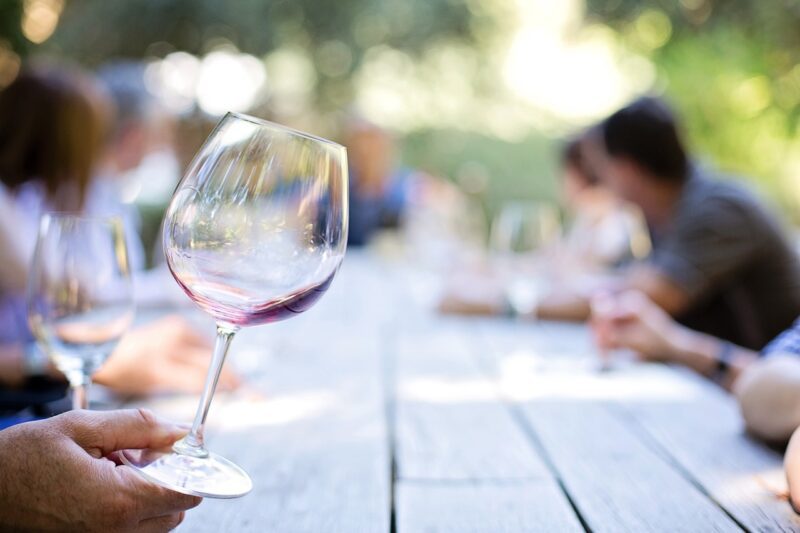What do things mean in the wine world?
Explore Corked News comprehensive wine glossary featuring detailed terminology and definitions related to the world of wine. From Acescence to Zymology, uncover the essential terms that encompass grape varieties, winemaking techniques, tasting notes, and more. Enhance your wine knowledge and appreciation with our extensive glossary resource.
A
Acescence: The presence of acetic acid in wine, resulting in a vinegary or sour aroma and taste.
Acidic: Refers to wines with higher levels of natural acids, which provide a refreshing and tart taste, often described as crisp or zesty.
Aeration: The process of exposing wine to air, often through decanting, to enhance its flavors and aromas.
Aftertaste: The flavors and sensations that linger in the mouth after swallowing a sip of wine.
Alcohol: The ethyl alcohol produced through fermentation, contributing to the body, warmth, and balance of the wine.
Amarone: A rich, full-bodied Italian red wine made from dried grapes, resulting in concentrated flavors and higher alcohol content.
Appellation: A designated geographical region where grapes are grown to produce wine with unique qualities influenced by the local terroir.
B
Balance: The harmonious relationship between acidity, sweetness, tannins, and alcohol in a wine.
Barrique: A small oak barrel, typically holding 225 liters (59 gallons), used for aging wine and imparting oak flavors and aromas.
Bâtonnage: The stirring of the lees (sediment of dead yeast cells) during the winemaking process, enhancing the wine’s texture and complexity.
Biodynamic: An agricultural approach that emphasizes organic practices and considers the holistic influence of the ecosystem on grapevines and wine production.
Body: Refers to the weight, texture, and overall mouthfeel of a wine, ranging from light-bodied (e.g., Pinot Noir) to full-bodied (e.g., Cabernet Sauvignon).
Bouquet: The complex aromas that develop in a wine as it ages.
Blanc de Blancs: A sparkling wine made exclusively from white grape varieties, most commonly Chardonnay.
C
Carbonic Maceration: A winemaking technique where whole grape clusters are fermented in a carbon dioxide-rich environment, resulting in fruity, low-tannin wines.
Cask: A large wooden barrel used for aging and storing wine.
Champagne: A sparkling wine produced in the Champagne region of France, made using the traditional method.
Chaptalization: The process of adding sugar to grape must before or during fermentation to increase the alcohol content in the finished wine.
Corked: A term used to describe a wine that has been tainted by a faulty cork, resulting in undesirable aromas and flavors.
Claret: A term commonly used in the United Kingdom to refer to red Bordeaux wine.
Cru: A term commonly used in France to designate a specific vineyard or wine-producing region known for producing high-quality wines.
D
Decanting: The process of pouring wine from its bottle into a decanter, separating it from sediment and allowing it to aerate.
Dosage: The addition of a small amount of wine and sugar (liqueur d’expédition) to adjust sweetness levels in sparkling wines during the disgorgement process.
Dry: A wine with minimal residual sugar, often associated with a more crisp and less sweet taste.
Dégorgement: The process of removing the yeast sediment from sparkling wine after secondary fermentation, typically done by freezing the neck of the bottle.
Dijon Clones: High-quality Pinot Noir and Chardonnay grapevine clones originating from the Burgundy region in France, widely used in many New World wine regions.
E
Earthy: A flavor profile often found in wines, characterized by notes of forest floor, mushrooms, or wet soil.
Enology: The scientific study of winemaking, encompassing all aspects of grape cultivation, fermentation, aging, and bottling.
Estate Bottled: Indicates that the wine is made entirely from grapes grown on the winery’s own vineyards.
Extraction: The process of extracting color, tannins, and flavor compounds from grape skins during maceration.
Extra Brut: A term used for sparkling wines with minimal residual sugar, often bone-dry and highly acidic.
F
Fermentation: The natural process by which yeast converts grape sugars into alcohol and carbon dioxide, resulting in the production of wine.
Filter: The process of removing solids or particles from wine before bottling, improving clarity and stability.
Finish: The lingering taste and sensation that remains in the mouth after swallowing a sip of wine.
Finesse: Refers to the elegance, subtlety, and refinement of a wine, often associated with balanced flavors and a seamless texture.
Fortified Wine: Wines to which a distilled spirit, such as brandy, is added, increasing the alcohol content and often resulting in a sweet or fortified style.
Frizzante: An Italian lightly sparkling or semi-sparkling wine, typically having less pressure than fully sparkling wines.
G
Grand Cru: A French term designating the highest classification level of vineyards or wines, indicating superior quality.
Grapes: The fruit of the vine, used as the primary ingredient in winemaking.
Green: A term used to describe underripe grapes or wines that exhibit vegetal or herbaceous characteristics.
Grafting: The process of attaching a vine cutting (scion) onto a rootstock, combining desirable vine characteristics with disease resistance or other beneficial traits.
Grüner Veltliner: An Austrian white grape variety known for producing aromatic and crisp wines, often with notes of white pepper and citrus.
H
Harvest: The process of picking ripe grapes from the vineyard for winemaking.
Herbaceous: A flavor or aroma profile reminiscent of fresh herbs, commonly found in certain white wines like Sauvignon Blanc.
Horizontal Tasting: A wine tasting where wines from the same vintage or region but different producers are sampled side by side to compare and contrast their characteristics.
Hybrid Grapes: Grape varieties resulting from crossbreeding different species or grapevine types, often selected for disease resistance or adaptation to specific climates.
Hogshead: A large oak barrel, typically holding 225 liters (59 gallons), used for aging wine. See “barrique“.
Honeyed: A descriptor for wines that exhibit rich and sweet flavors reminiscent of honey.
I
Indigenous Yeast: Naturally occurring yeast strains present on grape skins and in the vineyard that can spontaneously initiate fermentation.
Intense: Describes a wine with strong, concentrated flavors and aromas.
International Style: A winemaking approach characterized by producing wines with ripe fruit flavors, high alcohol, and noticeable oak influence, often associated with New World wine regions.
Inoculation: The deliberate addition of selected yeast strains to grape must to ensure a controlled and predictable fermentation process.
Irrigation: The process of supplying water to grapevines in vineyards when natural rainfall is insufficient, helping to regulate vine growth and grape development.
Isle St. George: A term used to refer to the vineyard and wines of the Saint-George appellation on the island of Jersey, located in the English Channel.
J
Jammy: Refers to wines with rich, ripe fruit flavors, often associated with red wines like Zinfandel or Shiraz.
Jéroboam: A large bottle size equivalent to three liters or four standard wine bottles, commonly used for sparkling wines.
K
Kabinett: A German wine term indicating a level of ripeness and sweetness, often used for Riesling wines.
Keg: A container used for storing and dispensing wine, typically made of stainless steel or wood.
Kvevri: An ancient winemaking vessel originating from Georgia, used for fermentation and aging, typically buried in the ground.
L
Legs: The streaks or tears that form on the inside of a wine glass after swirling, indicating the wine’s viscosity and alcohol content. Also known as “tears”. (Tells nothing about a wines quality, it’s a myth!)
Late Harvest: Wines made from grapes that have been left on the vine longer than usual, resulting in higher sugar levels and often producing sweeter styles.
Lees: The sediment consisting of dead yeast cells and other grape particles that settle at the bottom of the fermentation vessel, often used for aging and enhancing wine texture.
Luscious: Describes wines that are rich, sweet, and full-bodied, often with intense flavors and a velvety mouthfeel.
Lutte Raisonnée: A farming approach that combines organic and conventional practices, aiming to reduce chemical usage while still managing pests and diseases.
M
Malolactic Fermentation: A secondary fermentation process in which tart-tasting malic acid is converted into softer-tasting lactic acid, adding complexity and reducing acidity in certain wines.
Magnum: A large bottle size equivalent to 1.5 liters or two standard wine bottles, often used for aging and special occasions.
Meritage: A term used for high-quality blended wines, typically from Bordeaux grape varieties like Cabernet Sauvignon, Merlot, and Cabernet Franc.
Méthode Champenoise: The traditional method used for producing Champagne, involving a secondary fermentation in the bottle to create carbonation.
Microclimate: The specific climatic conditions within a vineyard or vineyard site that can influence grape ripening and wine quality.
Must: The juice of freshly crushed grapes, including the skins, seeds, and solids, before fermentation.
N
Nebbiolo: An Italian grape variety famous for producing highly tannic and aromatic wines, most notably Barolo and Barbaresco.
New World: Refers to wines produced outside of traditional European wine regions, often characterized by fruit-forward styles and innovative winemaking techniques.
Noble Rot: The beneficial fungus Botrytis cinerea that can affect grapes under specific climatic conditions, leading to the production of sweet wines with complex flavors, such as Sauternes.
Nose: The aroma or bouquet of a wine, including the scents perceived when smelling the wine.
Nouveau: Refers to young wines that are released shortly after fermentation, often associated with Beaujolais Nouveau from France.
O
Oak: Refers to the use of oak barrels or oak alternatives during fermentation or aging, which can impart flavors such as vanilla, spice, or toastiness to the wine.
Old World: Refers to wines produced in traditional European wine regions, often characterized by a focus on terroir and a more restrained style.
Organic: A farming approach that avoids the use of synthetic fertilizers, pesticides, and herbicides, promoting ecological balance and sustainability.
Oxidation: The exposure of wine to oxygen, leading to chemical reactions that can alter the wine’s flavors and aromas, often resulting in a stale or nutty character.
Oenophile: A wine enthusiast or connoisseur who appreciates and enjoys the art and science of wine.
P
pH: A measure of acidity or alkalinity in wine, with lower pH indicating higher acidity and higher pH indicating lower acidity.
Pét-Nat: An abbreviation for Pétillant Naturel, a style of sparkling wine made using the méthode ancestrale, where the wine finishes fermentation in the bottle, trapping natural carbonation.
Phylloxera: A tiny insect that attacks grapevine roots, causing damage and eventual death of the vine. Phylloxera infestations devastated vineyards in the late 19th century, leading to the practice of grafting vines onto resistant rootstocks.
Pommace: The solid remains of grapes (skins, seeds, and stems) after they have been crushed and the juice extracted, often used for compost or distillation.
Port: A fortified wine style originating from Portugal, typically rich, sweet, and high in alcohol, often enjoyed as a dessert wine.
Q
Qualitätswein: A German term indicating a quality wine produced from ripe grapes and adhering to specific quality standards.
Quinta: A Portuguese term referring to an estate or vineyard, often associated with Port wine production.
Quince: A fruit with a tart and astringent flavor often used to describe certain aromas or flavors found in wine, particularly in aged or oxidative styles.
R
Reserva: A term commonly used in Spain and Portugal to indicate a wine of higher quality or extended aging.
Residual Sugar: The amount of sugar that remains unfermented in a finished wine, contributing to sweetness.
Riddling: The process of slowly turning and gradually inverting sparkling wine bottles to collect yeast sediment in the neck of the bottle before disgorging.
Robust: Describes wines that are full-bodied, powerful, and intense in flavor and structure.
Rosé: A style of wine made from red grapes with limited contact between the grape skins and juice, resulting in a pink or salmon-colored wine.
S
Sommelier: A trained wine professional responsible for wine selection, service, and pairing recommendations in restaurants and other establishments.
Supple: Describes a wine with smooth and soft tannins, often associated with a pleasing mouthfeel.
Sulfites: Chemical compounds, including sulfur dioxide, used in winemaking as a preservative to prevent oxidation and microbial spoilage.
Sur Lie: The practice of aging wine on its lees (sediment) for an extended period, enhancing complexity, texture, and flavor development.
Syrah: A red grape variety known for producing bold, spicy, and full-bodied wines, also known as Shiraz in Australia.
T
Terroir: The combination of soil, climate, and environmental factors that influence the character and quality of wine from a specific vineyard or region.
Tannins: Natural compounds found in grape skins, seeds, and stems that contribute to the structure, bitterness, and aging potential of a wine.
Tastevin: A small, shallow silver or pewter cup used by wine professionals to evaluate the color, clarity, and aroma of wine.
Tasting Notes: Descriptive observations and comments on the appearance, aroma, taste, and overall characteristics of a specific wine.
Tinta: A Portuguese and Spanish term for red grape varieties.
U
Ullage: The space between the wine and the top of a bottle, often used as an indicator of a wine’s age and potential oxidation.
Ugni Blanc: A white grape variety widely used in the production of Cognac and other brandies.
Unctuous: Describes a wine with a rich, smooth, and oily texture, often associated with sweet or high-alcohol styles.
V
Varietal: Refers to a wine made primarily or exclusively from a single grape variety, displaying the unique characteristics of that particular grape.
Viniculture: The art and science of grape cultivation and winemaking.
Vinification: The process of making wine, including the steps of harvesting, crushing, fermenting, aging, and bottling.
Vintner: A person who makes or sells wine, often used to refer to a wine producer or winemaker.
Vitis Vinifera: The species of grapevine that includes most wine grape varieties, known for its superior quality and diversity.
W
Wine Faults: Undesirable characteristics or flaws in wine, such as oxidation, cork taint, or volatile acidity.
Winemaker: The person responsible for overseeing the winemaking process, from grape selection and fermentation to aging and bottling.
Wine Spectator: A prominent wine publication known for its wine ratings, reviews, and articles on the world of wine.
Wine Advocate: A highly regarded wine publication founded by Robert Parker, known for its influential wine ratings and reviews.
X
Xarel·lo: A white grape variety commonly used in the production of Cava, a sparkling wine from Spain.
Xinomavro: A red grape variety predominantly grown in Northern Greece, known for producing robust and tannic wines.
Y
Yeast: Microorganisms responsible for fermenting grape sugars into alcohol, converting grape juice into wine.
Yeasty: A characteristic aroma or flavor in wine resulting from the presence of yeast during fermentation or aging.
Young: Describes a wine that has not undergone extensive aging and is intended to be consumed relatively soon after bottling.
Z
Zinfandel: A red grape variety primarily associated with California, known for producing wines ranging from fruity and jammy to more structured and complex styles.
Zymology: The scientific study of fermentation, including the process of winemaking.





